
Votre Art à ma façon
The process of designing arty and unique dresses by JUSTE UNE IMPRESSION being fundamentally an artistic process, it seemed obvious to me that this could be applied to other contemporary works, obviously with the agreement of their authors.
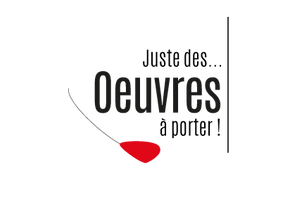
The idea being
to transpose art where we do not necessarily expect it (Pop Art, right?),
to focus differently on these artists to give them visibility,
but also and above all to give another perspective to the original work.
The photographs of the works are reworked (in particular in color density, sizes) before being printed and inked in the textile fiber permanently and indelibly ( no alteration whatever the number of machine washes at 30 ° ). The patronage is done manually by the designer in a subjective way to give a new perspective to the initial work necessarily truncated by the trapezoid cut of the dress.
my approach
Even if this exercise of highlighting artistic works through my textile design process is a priori transposable to a certain number of works, I have the postulate to choose both the works and the artists themselves, the human being as important to me as the work itself.
As a graphic designer, designer and creator, I have a graphic & aesthetic line ... as an artistic line of conduct, an editorial line for a coherent overall aesthetic & graphic.
These artistic collaborations have imposed themselves as aesthetic and human evidence, drawing from their respective universes other possible variations of my emblematic brand dresses.
ARTY DRESSES
















The artists
Gilles OUAKI
French photographer Gilles Ouaki began his career through photojournalism, a real lifeline for this suburban child who could have turned inside out.
He finds his way, becoming the eyes of others. For twenty years, Gilles Ouaki, in turn a great reporter for the Parisian and then at Paris-Match, followed the news from the news to the glamor of the stars. Mesrine, Action Directe, Carlos, Ouaki's goal sublimates the death of a gangster or the smile of people. Between an evocation of Warhol's “electric chair” or Monory's “murders”, his pictures offer a direct relationship with realism. Ouaki obtained, in 1982, the Grand Prix of the City of Paris and the Grand Prix Paris Match for his work.
At the same time, the artist photographer develops a passion for contemporary art: "Artists are beacons that light up the world and our world needs it"! In 1998, Ouaki took the plunge and became a performer by exposing to FIAC the boss of Free Figuration, Robert Combas for “The Wall”, controlled hallucination of glittery graffiti and photos denouncing the modern man walled in “prison-society ”.
Gilles Ouaki is an artist of his time who provokes improbable encounters. Hunter of emotions, creator of dialogues, he does not forbid anything. In the Val d'Oise, in 2009 he established a new artistic biennial, "the Grand Bet [s] of Contemporary Art". The greatest artists were present: Wiliam Klein , ORLAN , Gérard Fromanger ...
In 2010, Gilles Ouaki joined the family of designers and presented his latest creation, Cheese during the tenth edition of Designer's Day. He offers a giant Brownie camera as a sofa, bookcase, plasma screen, lamp… a job which will earn him the qualification of “one of the most essential contemporary artists of his generation” (Current Art).
His talent is recognized by public and private actors on the art scene: from Designer's Day, Gilles Ouaki finds himself propelled to the Grand Palais to exhibit in solo show. He is presented as one of the 10 major world photographers at the “Paris Photo” 2010 show by Leica alongside Jane Evelyn Atwood or Stanley Green. The same year, for the 30 years of the L'Eclaireur conceptstore, Armand Hadida entrusted Gilles Ouaki with the organization of a performance for this anniversary.
But Gilles Ouaki especially appreciates the experience of percolation and hybridization: with Bye-Bye Polaroïd in 2009, he celebrated the end of the Polaroïd by developing a work of “sharing” with his artist friends. Objective: produce snapshots that become the support for a new work. Arman , Ben, Robert Combas, Bernard Venet, Nathalie Elemento, Fabrice Hyber, Joël Hubaut, Jean-Paul Goude, Erro, Monory, Orlan, Rancillac, Pierre Soulages, Jacques Villeglé, Yann Queffélec all responded!
In 2012, he did it again; this time, the work of alchemy works with the greats of Street Art, invited to intervene on vintage shots of the artist Ouaki. These black and white gangster and street images are revisited by streetarters. Result: Cope2, Faucheur, Monsieur Chat, Speedy Graphito, Konny, ThomThom, Paella ... 43 street art artists participate in NB & Coulour. But the artist does not forget his work as Performer, on the Pont des Arts with the operation I Lock You, Gilles Ouaki releases and breaks the padlocks of the mythical Parisian Bridge to immortalize them in large format at the Carrousel du Louvre during the Tranoï 2012.
Jean-Michel GNIDZAZ
After a decade of reflection devoted to geometric compositions, Jean-Michel Gnidzaz today breaks with pure abstraction, and gives a new orientation to his work. Since 2003, he has initiated a new series of portraits devoted to cultural icons of the 20th century. Struck by the persistence in the collective unconscious of certain images or photographs of major cultural personalities of the 20th century, in particular those which are synonymous with a rebellion against the established order, Jean-Michel Gnidzaz questions here their iconic status. By neutralizing the background of the original photography, by recomposing the portrait from games of bi and tri-color, flat and alternating colored bands which reintroduce a certain kineticism, it deprives these incunabula of contemporary history of an identification too immediate. Thus discarded for a moment from the consensus, from the agreed respect that is usually reserved for them, these popular idols find a certain capacity to harass the spectator. The process pushes us to take a quick historical step back to evolve our questions: what would the Beatles, James Dean, or even Coluche mean in our society today; what place will they occupy in the minds of future generations; will they escape the decorative status to which the mercantile exploitation of their image has relegated them? No one has the answer yet, but the work of Jean-Michel Gnidzaz wisely questions. This new series of portraits, and the flood of questions it raises are certainly posed as a new essential milestone in her artistic journey and makes us curious about her future developments.
Amiel grumberg
Anne MONDY
Born in 1972, Anne Mondy is a designer who creates collages
and blends from an early age.
Daughter of actor and director Pierre Mondy, she has been swimming since
always in an environment where freedom of creation, originality and
artistic expression has a prominent place.
Anne develops her own imagination. She likes colors,
iconography and pop culture, street art, old comedies
musicals of MGM, the 80s, Soul music and series
American ... His passion for the plastic arts is quickly orientated
towards collages thanks to which she finds endless possibilities
of expression.
For 23 years, she worked as press officer and director
artistic in the performing arts, while continuing the practice
of the visual arts confidentially.
Strong and enriched by this career, Anne decides, 3 years ago, to embark
in a new challenge, a new chapter and to broaden his horizons
professionals. She chooses to bring her
artistic activity and to devote oneself only to this one.
And why not… ?!
POO
KKY
Qualified and inserted in the “STREET ARTIST” box, this highly sensitive self-taught free electron qualifies himself as “LOUNGE ARTIST”, because he works exclusively in his living room or kitchen.
After having worked for more than 10 years as a landscaper, he radically changed direction following a small accident in life and immersed himself in artistic creation through therapy.
he experiments with different and varied techniques to achieve this result, including the collage of posters collected from the streets, painting, digital retouching, stencils, etc.
Very influenced by Pop Art, he declines the icons from the 60s to the present day according to his desires and current events while integrating a little note of humor or a claim that concerns him.
POOKKY, that's its name, has decided to sign his works under different “crazy” pseudonyms in order to bring the viewer into his slightly crazy and quirky universe while including a part of mystery.
Philippe WATTEZ
Philippe Wattez, allias Lipphi is a painter who has distinguished himself in a wide variety of pictorial fields: trompe l'oeil, the restoration of works of art, theatrical decor, the scenography of amusement parks ( in France, Italy, Spain, Dubai, Quebec, ...). From 2010 he developed a personal project, a traveling, fun, educational exhibition, for all audiences, entitled: “The Muses of Painters”. The project consists of 20 pastel canvases (100 x 80 cm) by the great masters of modern art (Matisse, Picasso, Dali, ...). To illustrate the point, the exhibition is accompanied by a popularization essay: " A light look at Modern Art " in which the painters are presented with a touch of humor but also erudition. Since 2015, the exhibition has been on view in several Italian cities including Pordenone and Venice as well as in France in Plougonvelin, Solliés-Ville, Libourne and Lille. In 2020 the exhibition will be enriched by ten new pieces, this time parodying the sculptors (Brancusi, Moore, César, ...). The set now made up of thirty pieces will be presented under the name: “ L'Atelier des Modernes ” In the spirit of an imaginary museum, “L'Atelier des Modernes” offers you through a necessarily somewhat restrictive selection , a representative overview of the history of modern art. The great masters are all too often presented with snobbery. The author of this project claims its offbeat aspect and access to the anecdotal so that it is within the reach of the greatest number.
Philippe PASQUA
Born in Grasse in 1965, Philippe Pasqua is a self-taught painter who eludes traditional institutions and channels. He drew inspiration from Francis Bacon and Lucian Freud and gradually established himself as one of the major artists of his generation. His art impresses, challenges, and fascinates.
In this new series, Philippe Pasqua has tried his hand at self-portraiture, treated in the same way as the other subjects. He slips discreetly into the ensemble, and anyone unfamiliar with his face might miss it. Michel Lejeune could have written these words for these works: “…how is it that there is no internal sign that allows us to distinguish a self-portrait from a portrait?” Pasqua does not seek to present himself in one way or another. He does not stare at the viewer like Dürer, does not laugh like Rembrandt, is not delirious like Courbet, in distress like Van Gogh, haughty like Picasso or Warhol. He is serene, peaceful, and, like many of the subjects in the exhibition, his eyes closed. Unsettling, since the exercise of portraiture accustoms us to a face-to-face encounter where interaction takes place through the gaze. Disturbing, because we cannot help but make the connection with the wax death masks of the 19th century. But these closed eyes lead us, in spite of ourselves, to breathe and, in turn, to look inward, to listen to our sensations, to invisible.

Very proud of his trust and of this encounter, as improbable as it was incredible,
Philippe Pasqua offered me several of his portraits for the exercise.
I chose this self-portrait
to (re)present him... as you've never seen him before.
through his graphite drawing inked into a unique dress,
an iconic dress dedicated this time to the man, the artist.

Jérôme
JASINSKI
THE 3D GEOMETRICAL ART OF
JÉRÔME JASINSKI
The playful pop art of the photographer, cabinet maker and sculptor Jérôme Jasinski creates the surprising impression of an unexpected form of 30 art. One inevîtably thinks of the work of Vasarely, with its imaginative geometrical forms. But beyond that, there are also the astonishingly complex perspectives created by his shimme
ring palette of bright yellows and oranges, as well as the vibrant reds, that were so characteristic of the spirit of the Seventies and of his childhood in a family of artists.
His first contact with WOOd as a medium was also a major revelation. From that point on, he chose to focus on cabinet-making which he studied for four years. When he became a professional designer and creator of furniture and other objects. he spent his weekends creating original pieces for fun. and gave them to friends. His family encouraged him to share his work on Facebook and in a few days he was signing his first contract for an exhibition at the Galerie Sandrine Heerebout
Word of mouth did the rest and the response was enthusiastic. His work was noticed in a gallery in the Rue Blaes in Brussels by Michel Launoit. designer and director of the MIMA. who took him under his wing and organised one exhibition after another Orders for his pieces took off and soon he had become a full-time artist His first solo show at the B19 was soon followed by shows at The Belgian Gallery and the Salon Eurantica. at the Art Unity Gallery in Knokke from March 5-13 and at the Hamton Art Gallery 1n New York. ln just four short years. this previously unknown artist had sold over 200 unique works to art collectors.
What is the "Jasinski touch"? Spontaneous and persona! pieces of work which emerge from an instinctive process combined with the aesthetic pleasure of a clean, architectural finish. His ability to "see in 30" and his sense of the right finishing touch allow him it to create powerful kinetic and optical objects. The precision of his lines results from meticulous preparation with drawings and the study of proportions in 30, and a constant concern for consistency and pace.
The orchestration of one of his creations. which can sometimes consist of several hundred pieces. is in itself a performance. Like a magician, he uses optical tricks to play with the visible and the invisible and his visual effects change our perception of the volumes.
Finally, the spirit that characterises his worl< is without a doubt that of joy. Joy expressed both through his choice of colours - when he's net playing with black and white - and the titles of his creations, word plays in French such as "Pacômes Leszautres", "Sam Chatouille", "Alex Tazie", "Oino Zore" and so on.
This remarkable - and much noticed - work also succeeds in not taking itself too seriously. lt is fun to look at white also inspirlng serenity.
L'oeuvre originale "Ines Pere" versus la robe
A new artistic challenge through this collaboration: starting with an angled photo of one of Jérôme's works/sculptures, I imagine focusing his work in a different way and creating a sculptural volume effect through my re-drawing of his truncated/distorted work to create a different relationship with his work and restore a sense of volume to this printed area.
Challenge accomplished!
Fabrice
AINAUT
Through complex volumes where the straight line and the plane play an essential role, Fabrice Ainaut manages to find new paths that give shadow and light the space they need to engage in their confrontations in an ever-unpredictable dialectic.
A lover of black and white, when it comes to color, the artist pays extreme attention to the invention of contrasts, which he seeks to make ever more different, more unstable, and fleeting.
The central idea pursued by Fabrice Ainaut—an almost utopian idea, but one he is right to hold on to, because the future is open—is to breathe life into his works. He thus turns toward a particular robotics that leads him to develop an autonomy of interaction between the movements of the work and the simple presence of the viewer before it, the artist remaining the one who controls the modalities of this autonomy. This is where the artist's research comes from to improve the performance of his frequent use of computers and microcontrollers, in order to better program the complex assemblages of movements he inscribes in the various pieces that make up his works.
Fabrice Ainaut has an ideal, and this ideal is to succeed in constructing works that possess true intelligence, an intelligence that would give them the means to self-transform.
Fernand H. Fournier
Paris, January 2016


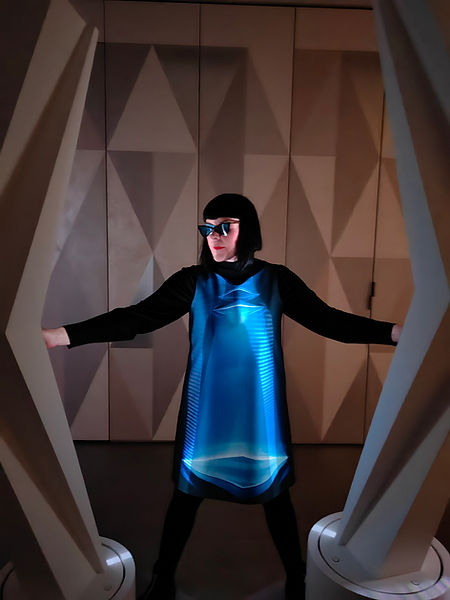
Another artistic challenge through this collaboration: transforming one of his light sculptures into a tableau vivant dress to showcase his art beyond the walls.
The tableau dress is delivered on site under the watchful eye of the master at the Wagner Gallery, which represents him.
You witness this powerful moment of the artist's relationship with his reinterpreted work. / Note that the reading here is vertical, whereas it is horizontal in the original work.
A live validation of the idea that seduced him, even though he would never wear his tableau dress, convinced that it was a unique way to bring his work to life, an idea that was dear to him.

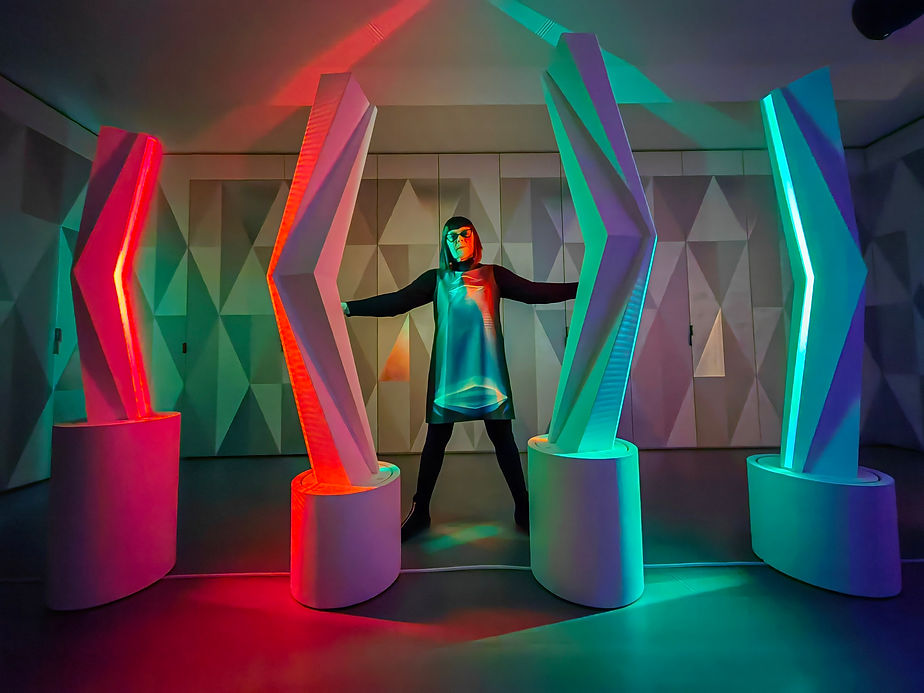

Aude
MILESI
"I define myself as a "word colorist." I raise awareness among my audiences about the importance of word choice. I paint and write about positive words to restore their meaning and bring out their vibration. Confucius's quote, "A picture is worth a thousand words," then takes on its full meaning when I exhibit my paintings to foster, among other things, awareness of the messages in words."
I set up my studio in my consulting office. Entirely self-taught as a painter, I discovered my talent for painting late in life.
I began in November 2020 with the creation of the Positive Energies Oracle, which I created without imagining creating art. I quickly realized that I painted through channeling and that it was my soul that worked, hence the artist pseudonym I chose: Â.M.
My meeting with Aude Milesi was a natural fit. Convinced that as an artist, and a woman at that, it was important for her to imagine wearing her art and claim it in order to be identified as the author of the paintings from which the unique dresses designed in artistic collaboration were produced.
The co-produced dresses are a communication tool in a personal branding approach, much like my own, since I embody and wear my own creations.
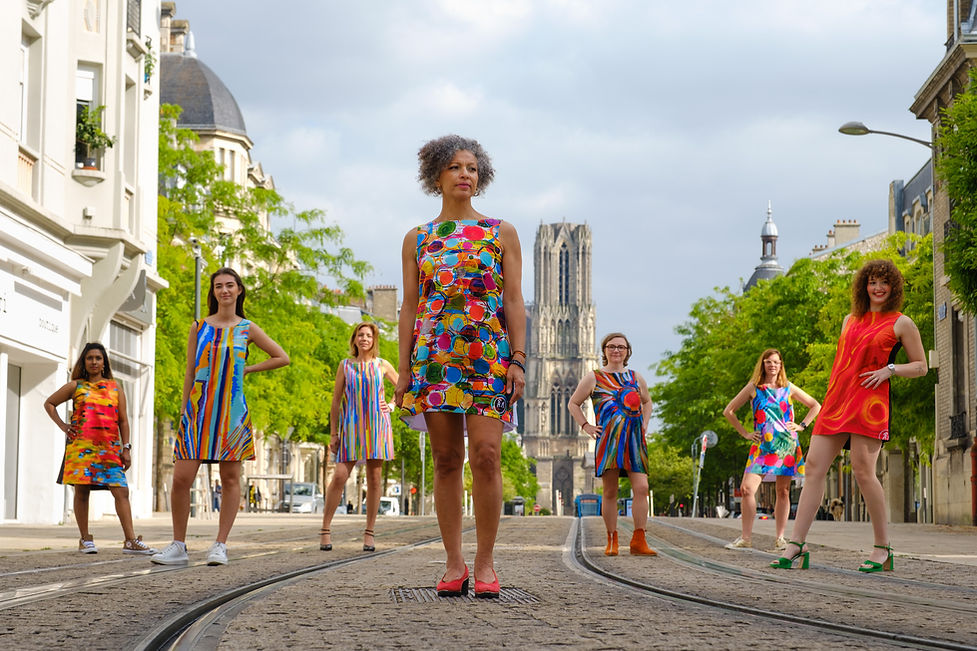
Ode
BERTRAND
"Bringing chaos into order": this is the challenge Ode Bertrand pursues through her work.
A student, assistant, and confidante of the great Aurelie Nemours for 35 years, her work as a painter also draws on concrete art, but from different premises: where Aurelie Nemours explored plane and color, Ode Bertrand focuses on line, which she uses both as a sign and a structure to subvert geometric figures defined around the golden ratio: grids, labyrinths, triangles, etc. Her works, which at first glance appear refined and orderly, reveal to the attentive observer an unsuspected abundance and seem to vibrate with an intrinsic life.
Excerpt from "Ode Bertrand – Line and Light," a monograph by Serge Lemoine (March 2008)

My meeting with Ode BERTRAND was initiated by the Florence WAGNER gallery (Paris). Mistress in her Art, the mastery of lines, of traits to make abstract geometric figures with a particular work on the articulation of black and white, a human meeting above all full of admiration for my part. She lent herself to the artistic meeting to the point of proudly wearing one of my designer masks, surprised and admiring my approach of transposing major works onto textiles, including hers to make her painting "on the point" a unique dress.
Mathias KRISSMER
"The aim of my work is to animate simple basic geometric shapes and patterns in moving video animations. To do this, I research the aspects of time, color, form, and light as well as their perception. Additive arrangement creates large, strictly geometric forms, whose arrangements and movements sometimes appear random. My basic forms are squares, circles, triangles, lines, crosses, and sometimes curves. Through targeted manipulation of time, e.g., through time shifting, I develop various structures and movement patterns. On the one hand, these are characterized by their dynamics and variability, but on the other hand, they exhibit a pronounced conceptual rigor. Basic movements of the forms such as rotation, scaling, positioning, as well as changes in color and shape serve as basic elements for new compositions.These are subject to a constant process of evolution, which leads to the continuous creation of new variations on a theme. The movement of the basic forms also creates constantly changing spaces between them. Time is made visible through the movement of the forms. The works have no beginning or end and can therefore be performed indefinitely. Speed plays a crucial role in the perception of optical effects and is an important part of the compositions. The emphasis on movement is supported by the use of the non-colors black and white, sometimes supplemented by one of the primary colors. This creates strong contrasts that clearly distinguish the forms from each other and from the background. White light emerges from the support and also illuminates the surroundings of the piece. The light highlights the forms and structures from the invisible black. The works are not bound to physical supports or the technical framework of a reproduction medium or projection surface. The artworks can be broadcast from mobile phones to large video screens or LED walls.
III00000I0III000I0 - oeuvre animée native de Mathias KRISSMER
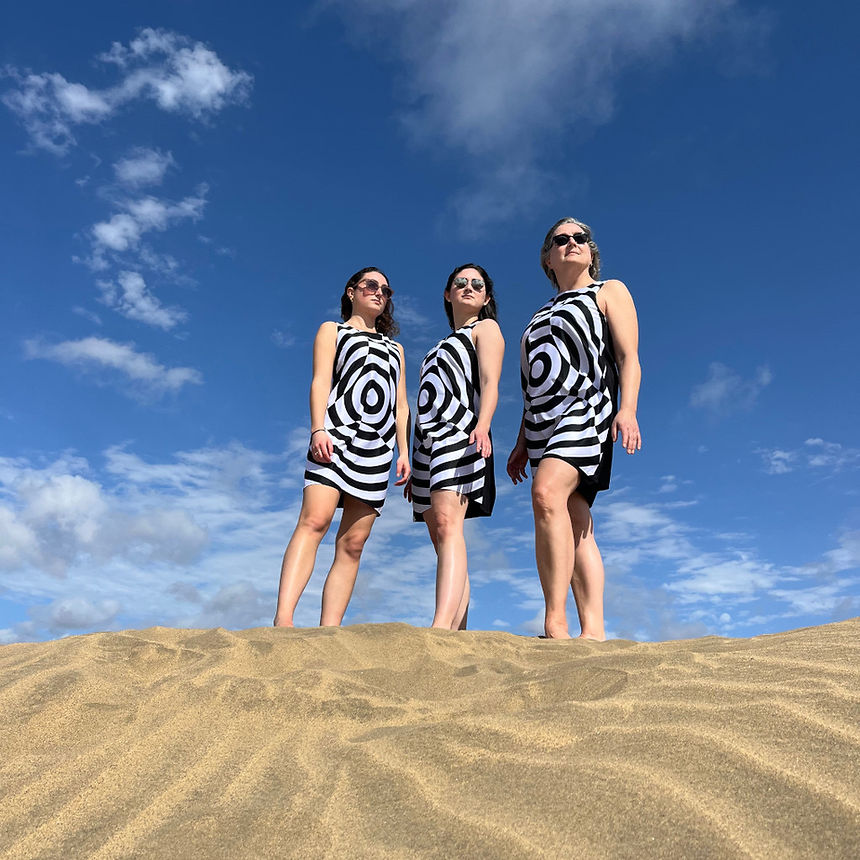
I met Mathias Krissmer via social media, driven by a shared passion for Optical/Kinetic Art. He spontaneously offered to reinterpret one of his animated works and transform it into a ready-to-wear Art dress. The challenge here was to redesign one of his animations to freeze it for the duration of a print, thus conveying the movement so dear to this artist through the movement of the model worn.
He is wearing a unique mask designed to mark this artistic collaboration and allow him to wear his Art.
Michel
DELAUNAY
Michel Delaunay, born in 1951, graduated from the Rouen School of Fine Arts in 1978.
He immediately joined the school as a professor of Geometry/Perspective.
There, he continued his research on questions of form and space. For some time now, Michel Delaunay has been picking this cube, the fruit of his research in this Garden where he loves to draw his imagination. He explores and exhibits this hexahedron from all angles, where emptiness gives meaning to matter, inviting the eye to plumb the depths of his creations. His works are based on the constituent features of the appearance of reality as its cutouts reveal them. One must know how to read between the lines to decipher and perceive beyond. Thus, his cutouts, presenting a collection of compact objects, address mythological and philosophical questions that provide him with an opportunity to express utopian perspective, the ambiguities of vision hidden behind the veil of illusion. Isn't it vanity to think of attaining unattainable knowledge? He tries not to look back on the past; the path is made by walking in the present, in order to thus strive, in the future, towards a truth, even if it is only an approximation.
And to conclude by admitting his inability to copy the cube, monocular perspective can nevertheless "suggest" its impression.

robe portée par Christelle,l'épouse de Michel DELAUNAY, en résonance avec l'oeuvre originale portée par son auteur.
60x60 decomposition,
paper cutout
currently on display at the Galerie Fontaine - Rouen

"Thank you, Véronique Fournier, for enhancing my work. An aesthetic and cultural dialogue that transcends your signature dress into a true medium of expression." Michel DELAUNAY










































































